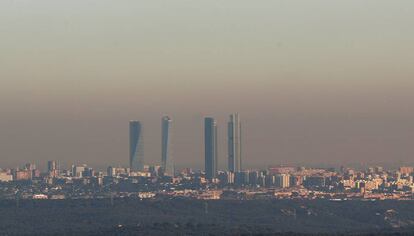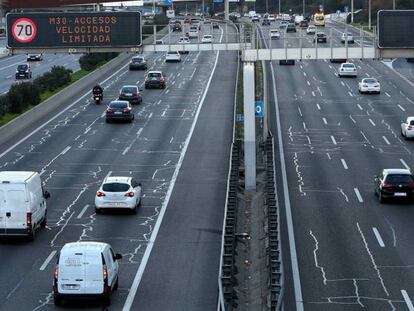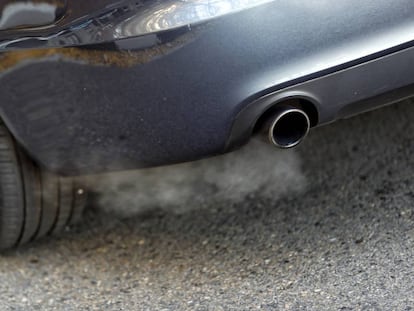Madrid bans half of all cars from city center as pollution levels spike
All vehicles will be allowed back into the capital on Friday, council announces

Motorists in the Spanish capital were hit with unprecedented measures on Thursday to reduce traffic with only vehicles whose license plate ends with an odd number permitted to enter the city center. The current levels of nitrogen dioxide (NO2) in the Spanish capital have prompted the council this week to first impose speed limits on certain roads, and then to restrict parking in regulated spaces in the city center – a situation classed as “scenario two.”

Thursday’s measures, part of phase three of a municipal protocol aimed at combating current high levels of air pollution in the capital, came into force at 6.30am on Thursday. But by mid-morning, the council announced that all vehicles would be allowed back into the center on Friday and Saturday. Scenario two will be in place those days, City Hall spokesperson Inés Sabanés announced, after a slight improvement in air quality was detected at measuring stations on Wednesday night.
On Thursday morning, meanwhile, City Hall said extra police and traffic officers had been drafted in and some were carrying out random checks on privately owned cars circulating within the M-30 beltway and imposing fines of €90 on car owners who have breached the rules.
EL PAÍS reported a doctor trying to get to hospital had been fined, while self-employed people also said they had no choice but to use their cars and would be appealing against sanctions.
“Fine me if you want, but my daddy is waiting for me,” one driver who was stopped reportedly told a police officer.
"La alcaldesa de Madrid @ManuelaCarmena se ha propuesto fastidiar a los trabajadores" https://t.co/nm4aw82Syb pic.twitter.com/aJBMmIqKSu
— Antonia Laborde (@antonialaborde) December 29, 2016
"The mayor of Madrid (Manuela Carmena) is determined to make workers angry."
Meanwhile, in the capital’s historic La Latina neighborhood, one resident out for a walk with her dog said: “I don’t have a car. The traffic restrictions don’t affect me, but the pollution does.”
Initially, the plan for Thursday was to set up police checks at the main access points into the capital at its five main arterial routes. However, this has now been largely discarded after authorities realized that it would create huge traffic jams and worsen air pollution levels. But police and traffic officers will be posted at some 23 major traffic points in the city.
Tailbacks were reported on Thursday morning at the busy A6 intersection at Moncloa, in the northwest of the city as police attempted to restrict access.
In other areas, cars with even number license plates have been seen circulating, but it is unclear whether they have evaded police controls or have been allowed through.
Exceptions to Thursday’s ban include vehicles carrying three or more people, hybrid cars, and disabled drivers. Taxis and delivery vehicles are also allowed to circulate in the city center.
José, un comerciante de Madrid, apoya las medidas contra la contaminación, pero pide al Ayuntamiento más rapidez en la alertas pic.twitter.com/w7TuYNEWDz
— Luca Costantini (@LucaCostant) December 29, 2016
Madrid shopkeeper José is in favor of the measures but wants more timely information.
This week has seen a 70 km/h speed limit imposed on the M-30 beltway. Radar controls have been adjusted accordingly, and police and traffic officers posted on bridges using mobile radars as a further measure.
Madrid Deputy Mayor Marta Higueras announced on Wednesday that City Hall would be implementing phase three of the municipal protocol in a bid to combat a current wave of pollution.
The 70km/h speed limit that has been in place on the M-30 ring road and access roads to the capital will remain in place, while parking spaces will still be unavailable to non-residents in regulated areas. Private and public parking lots can, however, be used.
If phase three of the pollution plan is kept in place, cars with even license plate numbers will be able to access the center on Friday, with the restrictions alternating in step with odd and even days of the month.
ATUC, the association that represents most of Spain’s public transport services, has welcomed the measures, describing them as “useful and necessary”, but adds: “They will not solve the real problem of mobility in the city.” ATUC calls instead for: “The development of the current situation toward a sustainable mobility model with the goal of achieving cleaner, healthier and more habitable cities.”
With additional reporting from Antonia Laborde and Luca Constantini.
English version by Nick Lyne.
Tu suscripción se está usando en otro dispositivo
¿Quieres añadir otro usuario a tu suscripción?
Si continúas leyendo en este dispositivo, no se podrá leer en el otro.
FlechaTu suscripción se está usando en otro dispositivo y solo puedes acceder a EL PAÍS desde un dispositivo a la vez.
Si quieres compartir tu cuenta, cambia tu suscripción a la modalidad Premium, así podrás añadir otro usuario. Cada uno accederá con su propia cuenta de email, lo que os permitirá personalizar vuestra experiencia en EL PAÍS.
¿Tienes una suscripción de empresa? Accede aquí para contratar más cuentas.
En el caso de no saber quién está usando tu cuenta, te recomendamos cambiar tu contraseña aquí.
Si decides continuar compartiendo tu cuenta, este mensaje se mostrará en tu dispositivo y en el de la otra persona que está usando tu cuenta de forma indefinida, afectando a tu experiencia de lectura. Puedes consultar aquí los términos y condiciones de la suscripción digital.
More information
Últimas noticias
Maduro pleads not guilty before the federal court in New York: ‘I am still the president of Venezuela’
A new test can detect Alzheimer’s from a finger prick
UN team enters Sudanese city of El Fasher after paramilitary massacre: ‘It’s like a ghost town’
A recipe for resistance: Indigenous peoples politicize their struggles from the kitchen
Most viewed
- Gilles Lipovetsky: ‘If you want to live better and fall in love, take Prozac, don’t look to philosophy’
- Alain Aspect, Nobel laureate in physics: ‘Einstein was so smart that he would have had to recognize quantum entanglement’
- Maduro’s downfall puts China’s relationship with Venezuela to the test
- Why oil has been at the center of Venezuela-US conflicts for decades
- Alvin Hellerstein, a 92-year-old judge appointed by Bill Clinton, to preside over Maduro’s trial in New York










































